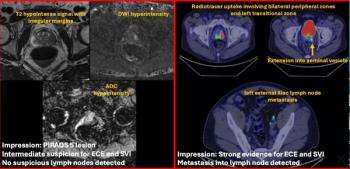
Siemens shows ceiling-mounted flat-panel C-arm for angiography
Focus is on usability, safety, image qualitySiemens Medical Solutions has begun marketing the Axiom Artis dTA, which it claims is the first digital ceiling-mounted universal angiography C-arm system equipped with flat-panel
Focus is on usability, safety, image quality
Siemens Medical Solutions has begun marketing the Axiom Artis dTA, which it claims is the first digital ceiling-mounted universal angiography C-arm system equipped with flat-panel detector technology. The system was introduced during the 2003 RSNA meeting in Chicago.
The C-arm system is the latest product built on the Axiom digital platform, which was cleared by the FDA in 2001. Artis dTA was grandfathered in for marketing in the U.S. under the FDA's nonfiling justification rule.
The system enables comprehensive routine diagnosis with advanced 3D image generation, maximum radiation protection, and optimal network connectivity, according to Henri Primo, manager of marketing and strategic relationships for Siemens. Artis dTA was designed for both vascular and nonvascular diagnostic and interventional procedures.
A 12 x 16-inch detector is designed to strike a balance between coverage and patient access, key issues when performing interventions. Artis dTA enables optimal image quality, including excellent contrast resolution that allows clinicians to view fine structures in great detail, according to the company. The ceiling-mounted design provides clinicians optimal access to patients from all sides, while permitting excellent rotational angiography and 3D reconstruction.
"The dTA can cover the patient head to toe," said Mark Lothert, segment manager for Siemens interventional radiology. "We have higher flexibility in positioning the system, which leads to better patient access."
The system comes equipped with an integrated optional ultrasound solution that arms clinicians with an additional medium for imaging patients in real-time. Other features include 60 degrees /sec C-arm movement in orbital and rotational directions and high-resolution volumetric images in less than a minute at minimal radiation dose. The system allows operators to switch from landscape to portrait mode with the flick of a switch for more thorough patient coverage, Lothert said.
Siemens executives project 2004 sales of 45 to 50 systems in the U.S. and 80 to 90 worldwide. Most installations will occur in large medical centers that specialize in interventional procedures. Much of the demand will come from users of Siemens' earlier generation product, the Multistar, according to Lothert.
The system lists for $1.8 million to $2.2 million. A key competitor will be the Philips Allura XperFD20 ceiling-mounted system, which cleared the FDA shortly after the RSNA meeting, according to Philips spokesperson Steve Kelly.
"Flat detectors are the future, no doubt about it," Lothert said. "The benefits include higher dynamic range and less noise in the image, which leads to better visualization of the catheter. Being able to do more with a system than just angiography will be very important."
The digital technology built into Artis dTA improves workflow and promotes time savings, while affording benefits in image quality and radiation dose, Primo said. These advantages accrue throughout the Axiom line of digital products.
"We realized early on that focusing on image quality alone was not enough to take advantage of the full potential of digital flat-detector technology," he said. "The intelligent integration of customized flat-detector technology in new systems, developed according to our principles of image quality, ease of use, and connectivity, allows us to offer our customers a well-rounded, applications-oriented digital system."
Newsletter
Stay at the forefront of radiology with the Diagnostic Imaging newsletter, delivering the latest news, clinical insights, and imaging advancements for today’s radiologists.




























